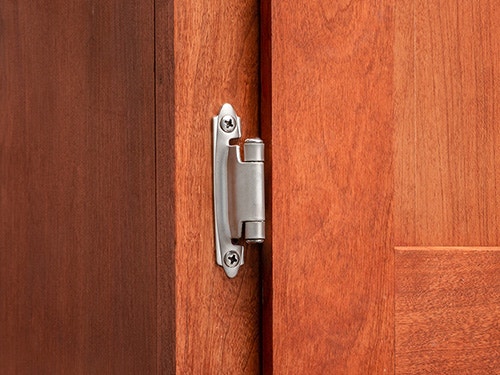Semi-Concealed Hinge Buying Guide
The term "semi-concealed" is applied when some of the hinge shows on the outside of the cabinet, but a portion of it is hidden behind the door. This guide will help you choose the right semi-concealed hinge for your project.
What is a Semi-Concealed Hinge?
While the term "semi-concealed" might seem confusing at first, it simply refers to the fact that part of the hinge is hidden behind the door. However, that's not the only defining factor. Many butt hinges and no-mortise hinges also wrap around the back of the door and/or face frame. But unlike those hinges, semi-concealed hinges offer the added benefit of being self-closing, or are offered with a self-closing option. And unlike butt hinges and no-mortise hinges, semi-concealed hinges are only designed for overlay doors or 3/8" inset doors. They will not fit full inset doors.
Why Buy a Semi-Concealed Hinge?
Semi-concealed hinges offer many of the same benefits as the more modern European hinges: they are typically self-closing, adjustable with slotted holes and much easier to install than a traditional butt hinge. Self-closing models don't require a door catch, which saves both installation time and the money spent on a catch. For these reasons, semi-concealed hinges were enormously popular prior to the introduction of European hinges.
So why buy a semi-concealed hinge instead of a European hinge? Unlike European hinges, semi-concealed hinges are visible on the outside of the cabinet. This being the case, they offer a variety of stylistic choices, both in shape and finish, that you can't get with a European hinge. They are also much more affordable than European hinges. Since they've been popular choices on cabinets spanning many decades, many semi-concealed hinges are also sold as replacement hinges. Even today, countless cabinetmakers continue to choose semi-concealed hinges because of their traditional styling paired with their self-closing action and easy installation.
If Semi-Concealed hinges sound like something you can swing, read on to find out how to choose the right one.
 |
Hinge TipIf you're building from scratch, you have the flexibility to decide which hinge you want. But be sure to select your hinges before you get started. Selecting hardware should be a critical element in the initial design stage. It's much easier to make a minor change in your design to match the required hardware than it is to rework a project in progress because the hardware you thought would be available can't be found. |
Which Semi-Concealed Hinge Should I Choose?
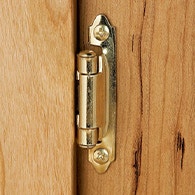 |
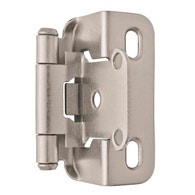 |
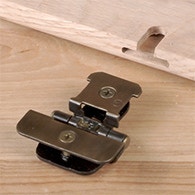 |
It may seem like there is an endless variety of semi-concealed hinges, but really, there are only three basic types:
- Surface-Mount Hinge: Surface-mount semi-concealed hinges (often called face-mount) are easily distinguished because the mounting screws are visible when the door is closed. This provides a certain traditional aesthetic that many like, and it also means that the doors are easy to install when the cabinet is lying on its back. Just set the door on the cabinet face, position and then drill and drive the mounting screws.
- Wrap-Around/Partial Wrap Hinge: Wrap-around hinges have a bent leaf that is screwed to the inside edge of the face frame. This means that the screws are not visible when the door is closed. Wrap-around hinges offer easy installation, since the bent leaf automatically sets an accurate, consistent hinge-side overlay without the need for measurement or jigs.
- Demountable Hinge: This is a unique hinge that mounts to the cabinet and/or door in a specially-machined T-shaped slot. This mounting method allows the hinge and door to be easily removed or adjusted as needed. Demountable hinges come in two styles: Single Demountable, which fit a slot in the cabinet only, and Double Demountable, which fit a slot in both the cabinet and the door. Since machining the T-shaped slot requires special tooling, Demountable hinges are uncommon in new cabinets today. They are most often sold as replacement hinges for existing cabinets.
Once you've settled on the basic type of semi-concealed hinge, the following questions will help you drill down to find the perfect hinge for your project.
Shop by hinge type: Surface-Mount | Wrap-Around | Demountable
 |
Hinge TipUse a self-centering bit to ensure the holes are accurately located. With holes perfectly centered, your screws will seat neatly and your hinges will sit right. |
Face Frame or Frameless Cabinet?
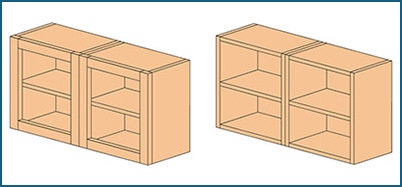
Generally speaking, Semi-Concealed hinges are intended for use with face frame cabinets. In fact, Face-Mount and Demountable hinges are only compatible with face frame cabinets. However, the Partial Wrap type (with a 1/4" overlay) can be used on simple frameless cabinets (with just one or two doors), since the hinge is screwed to the inside face of the cabinet.
 |
Hinge TipIf you're replacing existing hinges, start with trying to identify the manufacturer. Their name is often stamped on the hinge itself. If it isn't, go through this buying guide as if you were buying a new hinge. This should direct you to the best replacement hinge option. It's also a good idea to take the hinge off of the door and compare it visually with the semi-concealed hinges offered on our website. Once you think you've found a match, be sure that the overlay matches your existing hinge (see the video on overlay below). |
3/8" Inset or Overlay Doors?
 |
 |
Semi-concealed hinges are made to fit either 3/8" inset doors or overlay doors. As mentioned above, they will not fit full inset doors.
3/8" inset doors have a rabbet or shoulder (measuring 3/8" x 3/8") running around the edge of the door so that the door sits halfway inside the cabinet when closed. Hinges for 3/8" inset doors will be clearly labeled as such.
For overlay doors, no part of the door sits inside the cabinet when closed - the full thickness of the door overlays the cabinet. If your doors are overlay doors, it's important to know how far the hinge side of the door overlays the cabinet opening. Semi-concealed hinges are commonly available in 1/4'' or 1/2'' overlay, but are also sometimes available in ''variable overlay'' (scroll down for more on variable overlay). If you're building cabinets, you get to select the overlay. For replacement hinges, you'll need to measure the existing overlay with a tape measure. Use a pencil to make a small mark where the hinge side of the door overlays the cabinet face. Then open the door and measure from the inside of the cabinet opening to the tick mark that you made. When you buy your replacement hinge, make sure the listed overlay matches this dimension. Check out the video for an easy how-to on measuring overlay.
Shop by door type: 3/8" Inset | Overlay
Self-Closing or Free-Swinging?
Nearly all semi-concealed hinges are self-closing. This means that a spring engages in the final few inches of travel to pull the door closed. Thanks to this feature, no doors are left ajar, and there is no need for a door catch. Free-swinging hinges are sometimes also made available for small or narrow doors that would otherwise slam shut too forcefully. In this situation, installing one free-swinging hinge and one self-closing hinge per door lessens the closing force. Free-swinging hinges may also be used whenever a traditional catch seems more suiting - in furniture applications, for example
Shop by closing mechanism: Self-Closing | Free Swinging
 |
Hinge TipIf your doors are large, consider how many hinges you'll need per door. You do not want to install too many hinges on a door, but you need enough to support the door over time. Two hinges are the common configuration, but for larger doors, three or more hinges may be needed. |
Special Situations
 |
 |
Below are a couple of semi-concealed hinges that are offered to suit special situations.
Variable Overlay Hinge: If you want an overlay hinge that isn't restricted to a particular overlay dimension, look for a "variable overlay" hinge. With these hinges, the door can be positioned anywhere on the face frame, provided it covers the cabinet opening.
Reverse Bevel Hinge: This hinge is designed to fit doors that have a reverse bevel machined around the edge. The reverse bevel lets you easily grip the door edge to open the door, making knobs and pulls unnecessary. The leaf on this type of hinge is formed to follow the contour of the bevel.
Shop by special hinge type: Variable Overlay | Reverse Bevel
And that about covers it! Don't forget that we have expert staff in our stores, online and available by phone to help out if you have a question that's not answered here.
Click here to shop all Semi-Concealed Hinges.
See Our Hinge Glossary
Keep the inspiration coming!
Subscribe to our newsletter for more woodworking tips and tricks
